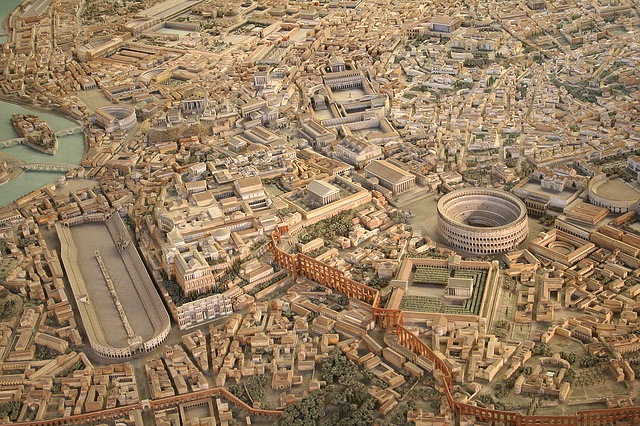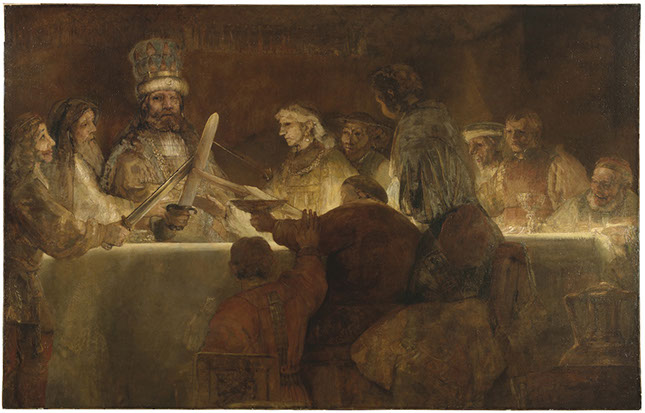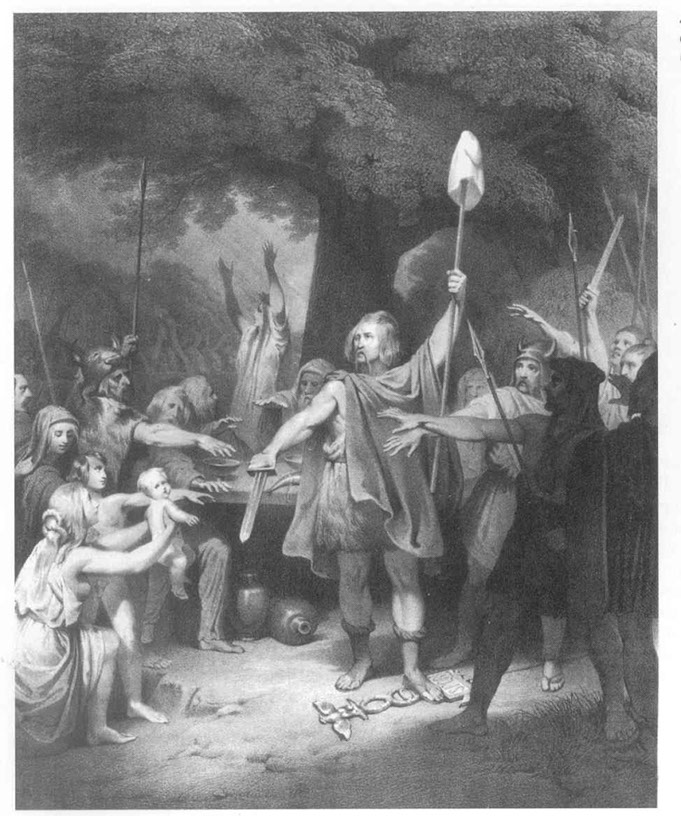
Fire In The Year Of Four Emperors
by Rick Deragon
an historical novel
Gaius Julius Civilis, the Year of Four Emperors,
and Rembrandt’s Conspiracy Painting

The protagonist of Fire in the Year of Four Emperors is Gaius Julius Civilis, to whom I have given a tribal name, Rokus, in the novel. Gaius Julius Civilis was a real first century character, a Batavian (present-day Netherlands) tribesman who (or whose family) had been granted Roman citizenship for reasons of service, bravery, loyalty, or a combination of these qualities. The Roman historian, Tacitus, writes that Civilis, "was unusually intelligent for a native, and passed himself off as a second Sertorius or Hannibal, whose facial disfigurement he shared."
After twenty-five years as a commander of a Batavian auxiliary in Britannia, having served in Claudius’s invasion force, Civilis tired of the Roman conscription policies that drew an inordinate number of Batavian youth into the Roman armies and bestowed much hardship on Batavian families. As Batavia was a flat, wet, unproductive land, the Romans saw the extraordinary Batavian horsemanship, swimming ability and fighting valor as a fitting substitute for taxes. Civilis and his brother allegedly made seditious remarks about Roman rule, and were declared traitors.
Civilis’s brother was assassinated when Roman guards seized them, and then the Roman guards took Civilis to Rome for a hearing before Nero, an act of protocol that indicated a respect for Civilis’s Roman citizenship, as well as his military record. In any case, he was imprisoned. After two years, he was released by Nero’s successor, Emperor Galba, who was the first of four Emperors in the year 69 CE.
My novel tracks Civilis (Rokus) from the time of his release from prison to his arrival back in Batavia. He makes the journey with a military escort. The Roman plan for him---to train northern men to be soldiers in senators’ private armies---doesn’t sit well with Rokus, and causes much soul searching. This is all my invention
(see Synopsis).

According to Tacitus, Civilis spearheaded a successful rebellion of northern tribes against the occupying Roman legions, weakened because many troops were in the south fighting in the civil war. As predicted by the Bructeri prophetess, Veleda, Civilis and his alliance of tribesmen from Germania, Belgica, and Gallia sacked one northern Roman fort after another, and even seized a good portion of the Roman navy stationed on the Rhine River. There seemed to be, for a short time, an opportunity for a new independent nation in the north.
The civil war: Emperor Galba enraged the Senate and Praetorian Guard with his post-Nero policies. He was murdered in the street. Ambitious Otho, Governor of Lusitania, succeeded Galba, but the army of Vitellius, governor of Germania Superior, defeated his army. Then the army of Vespasian, commander of forces in Egypt, Syria, and Judea, defeated Vitellius’ army. This fourth emperor of 69 CE sent a massive force north to suppress Civilis and his revolutionaries. The Roman general in charge, Quintus Petillius Cerialis, conducted a systematic pursuit of Civilis, and, notwithstanding clever leadership on both sides, Civilis was obliged to surrender. The bloody battles and powerful Roman legions had indeed squelched the northerners’ will to fight.
Civilis and Veleda disappear from history, according to some historians, while others describe the Roman-Batavian treaty as respectful and even amiable, with Civilis being sent to his homeland without punishment. Still other historians assert that some Roman patriot officers would not have accepted such an end to rebellion, and that the treaty was probably broken with Civilis’s crucifixion. In any case, Vespasian went on to build the Coliseum in Rome, ruled for ten years, and was followed by his sons, Titus and Domitian, the Flavian Dynasty.
My novel ends with the scene depicted in Rembrandt’s painting, The Conspiracy of Claudius Civilis, which just precedes the aforementioned revolt in the north. My interest in and appreciation for this painting, interestingly, provided the inspiration for writing this novel.

In 1661, the Amsterdam town fathers built a new town hall to celebrate victory over the occupying Spanish. They commissioned paintings from many Dutch artists to fill the lunettes and walls with subjects of patriotic heroism and victory, specifically focusing on one Claudius (Julius) Civilis, the Batavian revolutionary who, at least for a time, succeeded in throwing off the yoke of his oppressor. Seeing the Batavians as prototypes for the Dutch, the Amsterdam leaders believed Civilis’ story seemed perfect to express the spirit of the 1660s. Incidentally, the moniker, Claudius, was a mistake by Rembrandt and his countrymen, who assumed Civilis received citizenship from Emperor Claudius, whom he served. But history says his name was Julius, indicating Civilis’ family received citizenship during the reign of Augustus Caesar, a Julian. Art historians stick with Rembrandt’s title, even though it is inaccurate.

 For this commission Rembrandt painted a large interpretation of a Tacitus passage wherein the barbarians meet in a sacred grove, and after much drink and speech making, Civilis proposes a revolt against Rome. It was the largest painting Rembrandt had ever done. After being installed for two weeks or so, the Amsterdam authorities asked Rembrandt to take the painting back, because in their estimation, the characters depicted in it were not sufficiently heroic, handsome, or inspiring. In fact, they all look inebriated. Sir Kenneth Clark noted in his book, Introduction to Rembrandt, "one need only look at the surviving fragment to see why official opinion could not accept it.... It is a most marvelous picture, but in places it borders on the absurd. The word Shakespearean is, for once, justifiable. Rembrandt has evoked the kind of quasi-mythical, heroic-magical past that is the setting for King Lear and Cymbeline, and, as with Shakespeare, this remoteness has allowed him to insert into an episode of primitive grandeur the life-giving roughage of the grotesque (the figures at the extreme sides.)"
For this commission Rembrandt painted a large interpretation of a Tacitus passage wherein the barbarians meet in a sacred grove, and after much drink and speech making, Civilis proposes a revolt against Rome. It was the largest painting Rembrandt had ever done. After being installed for two weeks or so, the Amsterdam authorities asked Rembrandt to take the painting back, because in their estimation, the characters depicted in it were not sufficiently heroic, handsome, or inspiring. In fact, they all look inebriated. Sir Kenneth Clark noted in his book, Introduction to Rembrandt, "one need only look at the surviving fragment to see why official opinion could not accept it.... It is a most marvelous picture, but in places it borders on the absurd. The word Shakespearean is, for once, justifiable. Rembrandt has evoked the kind of quasi-mythical, heroic-magical past that is the setting for King Lear and Cymbeline, and, as with Shakespeare, this remoteness has allowed him to insert into an episode of primitive grandeur the life-giving roughage of the grotesque (the figures at the extreme sides.)"
Rembrandt cut the painting down to the cluster of men around the table, added the figure on the left, and then sold it off. The painting exchanged hands a couple of times, and ended up in Stockholm, where the owner lent it to Swedish Royal Academy of Art for display there. Scrutiny reveals an extra sword blade raised in the oath; it enters from behind the character to Civilis’ right. Close inspection by conservators revealed a repair and over-painting had been done so poorly, that the only solution appears to have been to paint over the damaged area with another sword. The Swedish Royal Academy of Art eventually purchased The Conspiracy of Claudius Civilis and arranged to have it put on display in the National Museum in Stockholm, where is remains.

© 2016 Rick Deragon